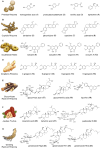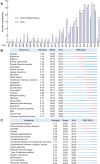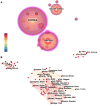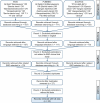Reunderstanding the classical prescription Banxia Xiexin Decoction: new perspectives from a comprehensive review of clinical research and pharmacological studies
- PMID: 40102869
- PMCID: PMC11921579
- DOI: 10.1186/s13020-025-01087-0
Reunderstanding the classical prescription Banxia Xiexin Decoction: new perspectives from a comprehensive review of clinical research and pharmacological studies
Abstract
Classical prescriptions of Chinese medicine represent the crystallized wisdom of millennia of clinical practice, enduring as cornerstones of therapeutic intervention due to their demonstrated efficacy across generations. Their evolving role in modern healthcare systems reflects shifting disease patterns, scientific advancements, and global health priorities. Banxia Xiexin Decoction (BXD), formulated by Zhang Zhongjing in the Treatise on Febrile and Miscellaneous Diseases (Shanghanlun), is a time-honored classical prescription renowned for its therapeutic versatility in managing gastrointestinal disorders, both in China and internationally. Recent advancements in clinical research and pharmacological studies on BXD underscore the necessity for a comprehensive bibliometric analysis to summarize and elucidate its specific clinical benefits. Through an extensive literature review of publications from the Web of Science, PubMed, Scopus, and the China National Knowledge Infrastructure (CNKI) between 1997 and 2024, 11 major categories of clinical applications for BXD were identified, along with an analysis of the potential pharmacological mechanisms, such as chronic gastritis, functional dyspepsia, and inflammatory bowel disease. We believe this review will provide new insights into the understanding of clinical value of BXD and identify potential future perspectives for its research and development.
Keywords: Banxia Xiexin Decoction; Bibliometric analysis; Classical prescription; Gastric ulcer; Gastritis.
© 2025. The Author(s).
Conflict of interest statement
Declarations. Ethics approval and consent to participate: Not applicable. Consent for publication: Not applicable. Competing interests: The authors declare that there are no competing interests.
Figures









Similar articles
-
Bioactive components of Banxia Xiexin Decoction for the treatment of gastrointestinal diseases based on flavor-oriented analysis.J Ethnopharmacol. 2022 Jun 12;291:115085. doi: 10.1016/j.jep.2022.115085. Epub 2022 Feb 9. J Ethnopharmacol. 2022. PMID: 35150814 Review.
-
Exploration of the potential mechanism of Banxia Xiexin Decoction for the effects on TNBS-induced ulcerative colitis rats with the assistance of network pharmacology analysis.J Ethnopharmacol. 2021 Sep 15;277:114197. doi: 10.1016/j.jep.2021.114197. Epub 2021 May 15. J Ethnopharmacol. 2021. PMID: 34004261
-
Banxia Xiexin Decoction in the treatment of chronic atrophic gastritis: A protocol for systematic review and meta-analysis.Medicine (Baltimore). 2020 Oct 16;99(42):e22110. doi: 10.1097/MD.0000000000022110. Medicine (Baltimore). 2020. PMID: 33080670 Free PMC article.
-
Traditional Banxia Xiexin decoction inhibits invasion, metastasis, and epithelial mesenchymal transition in gastric cancer by reducing lncRNA TUC338 expression.Heliyon. 2023 Oct 20;9(11):e21064. doi: 10.1016/j.heliyon.2023.e21064. eCollection 2023 Nov. Heliyon. 2023. PMID: 37964840 Free PMC article.
-
Efficacy of Banxia Xiexin decoction for chronic atrophic gastritis: A systematic review and meta-analysis.PLoS One. 2020 Oct 27;15(10):e0241202. doi: 10.1371/journal.pone.0241202. eCollection 2020. PLoS One. 2020. PMID: 33108375 Free PMC article.
Cited by
-
Mechanism of action of heat-clearing and detoxifying herbs in the treatment of erosive gastritis.World J Gastroenterol. 2025 Aug 7;31(29):110133. doi: 10.3748/wjg.v31.i29.110133. World J Gastroenterol. 2025. PMID: 40799369 Free PMC article. Review.
References
-
- Zhang C, Liu Y, Li H, Li B, Dong Y, Liu S. Analysis on evolution of clinical application of classic famous prescription Banxia Xiexin Decoction in ancient and modern times. J Basic Chin Med. 2023;29(03):452–6.
-
- Pharmacopoeia Commission of the People’s Republic of China. The Pharmacopoeia of the People’s Republic of China. Beijing: China Medical Science Press; 2020.
-
- Bai J, Qi J, Yang L, Wang Z, Wang R, Shi Y. A comprehensive review on ethnopharmacological, phytochemical, pharmacological and toxicological evaluation, and quality control of Pinelliaternata (Thunb.) Breit. J Ethnopharmacol. 2022;298: 115650. - PubMed
-
- Chen C, Sun Y, Wang Z, Huang Z, Zou Y, Yang F. Pinellia genus: a systematic review of active ingredients, pharmacological effects and action mechanism, toxicological evaluation, and multi-omics application. Gene. 2023;870: 147426. - PubMed
Publication types
Grants and funding
LinkOut - more resources
Full Text Sources

